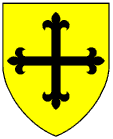
LIVES OF THE BISHOPS OF EXETER
THOMAS LAMPLUGH, of the ancient family of Lamplugh, of Lamplugh, in the county of Cumberland, Rector of St. Martin's-in-the-Fie1ds, London, and Dean of Rochester, was confirmed bishop on 2nd November, and consecrated successor to Bishop Sparrow on 12th November, 1676. Prince, the biographer, in his additions to Westcote's 'View of Devon,' observes that amongst many excellent qualities of a Christian bishop, "he was a lover of hospitality, which he expressed to all, especially to his clergy, whom he bade very welcome to his table." On the death of Dr. Cary, Rector of Shobrooke, on 2nd February, 1681, the new bishop had interest enough to procure for his see the perpetual annexation of that rectory. To its church he presented a very substantial, handsome silver flagon, bearing his arms, and this inscription: "Gratitudinis ergo benedicat Deus Thomas Lamplugh." In a printed sermon, delivered by the Rev. John Reynolds on 27th July, 1684, on the occasion of setting up seats and a pulpit in the nave of the cathedral (the removal of which in 1834 redounded to the credit of the members of the then chapter), the preacher commends this bishop for his special zeal in repairing churches and chapels, and for restoring the monuments of several of his episcopal predecessors to their original sites, "which during the Commonwealth had been thrust into the darkest corners of the cathedral, and there were rudely misplaced and obscured." He further praises his lordship's assiduity in "attending three times a-day in the cathedral, besides a fourth time in his private chapel, with a course almost as constant as the rising and setting of the sun."
When the Prince of Orange landed in Torbay, they bishop made a show of loyalty by exhorting the clergy and laity of the diocese to remain steadfast in their sworn allegiance to their crowned and legitimate king, James II. Nay, his lordship refused to receive the prince, and retired to London. In the life of that unfortunate monarch compiled from the Stuart papers by order of King George IV. (vol. ii. p. 237), we read, "to recompense this dutiful comportment, his Majesty conferred the Archbishopric of York upon him. The ceremony was forthwith performed at Lambeth, in November, 1688, and the next day, after, he did homage to the king for the translation: a great reward for one single act of duty; and more suitable to the king's generosity, than his real merit, who retracted so soon his short-lived loyalty, and was as ready to fly in his prince's and benefactor's face as the rest, when there was no more to be expected from him." Unquestionably he became a principal instrument in placing the crown on the Prince of Orange. But the old man enjoyed his honours and fortune for a very brief period, and, in the words of Prince, "within three years' continuance in that high throne of York, he was summoned before an higher." His epitaph in the minster records his death on 5th May, 1691, aged 76. We may be allowed to withhold our assent to Dr. Richardson's assertion, that he was elevated to the metropolitan see of York much against his inclination and entreaties, "tandem, licet dignitatem multam deprecatus, in Sedem hanc Metropolitanam evectus est."
Arms: - Or, a Cross fleurée sable.
